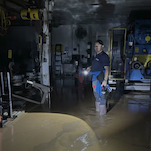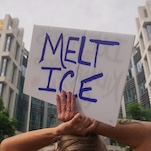As California goes dry, Latinos suffer disproportionately
To many Californians, the unprecedented water-use restrictions announced this week by Gov. Jerry Brown may no more than a nuisance, since most cities already have strict conservation measures in place.
But for many Latinos in the Golden State, the drought is resulting in lost livelihoods.
On Thursday, a group of elected officials from the state’s Central Valley, where Hispanic farm workers comprise a huge share of the region’s labor force, gathered outside the town of Selma’s city hall to denounce Brown’s continued refusal to send water to their region, and to send food rations instead.
They showed photos of what has happened in the region as a four-year drought has brought an economic crunch: shanty towns and bread lines. These photos were taken earlier this year near the town of Mendota:
This photo was taken last year, but it’s a scene likely to be repeated again as food supplies allotted in Brown’s new drought aid package are delivered.
“No water, no work, no life,” Selma Mayor Scott Robertson said at the event in Spanish, according to Fresno-based The Business Journal.
-

-

-

-

-

-

-

-

-

-

-

-

-

-

-

-

-

-

-

-

-

-

-

-

-

-

-

-

-

-

-

-

-

-

-

-

-

-

-

-

-

-

-

-

-

-

-

-

-

-

-

-

-

-

-

-

-

-

-

-

-

-

-

-

-

-

-

-

-

-

-

-

-

-

-

-

-

-

-

-

-

-

-

-

-

-

-

-

-

-

-

-

-

-

-

-

-

-

-

-

-

-

-

-

-

-

-

-












































































































